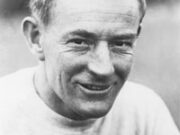George Cecil “Kid” Woodruff coached the University of Georgia football team from 1923 to 1927, bringing the Bulldogs’ program to national prominence. As an alumnus he was instrumental in the building of Sanford Stadium and the hiring of coach Wally Butts, and the Georgia practice fields are named after him.
Woodruff was born in Columbus in 1889. Nicknamed “Kid” because of his small stature, he began his association with Georgia when his older brother Harry (the first “Kid”) became the Bulldogs’ quarterback in the early 1900s. Woodruff followed his brother, playing quarterback from 1907 to 1911. He was captain of the 1911 team. Coach Alex Cunningham said of the diminutive Woodruff, “I would rather see that little bunch of nerve leading my team than any man I have ever seen.”
After graduation Woodruff became a successful businessman in Columbus, but in 1923 he was lured back to his alma mater by alumni and fans who wanted him to strengthen Georgia’s football program. Woodruff was a frequent visitor at Indiana’s Notre Dame football games and introduced the Irish style of football to Georgia and the South. He also brought with him three Notre Dame coaches—Frank Thomas, Harry Mehre, and Jim Crowley—who would become successful head coaches themselves.
The businessman Woodruff signed a contract to receive one dollar a year for his services, but Georgia’s small investment had a high rate of return. In 1927 the “Dream and Wonder” team won the Southern Conference championship and lost only to Georgia Institute of Technology’s team, a defeat that probably prevented the Bulldogs from receiving a Rose Bowl bid. Woodruff retired to Columbus after that season, installing Mehre as his successor, but he had accomplished what he had been hired to do. For the next forty years he was an active and avid University of Georgia supporter, as well as a member of the Board of Regents of the University System of Georgia.




